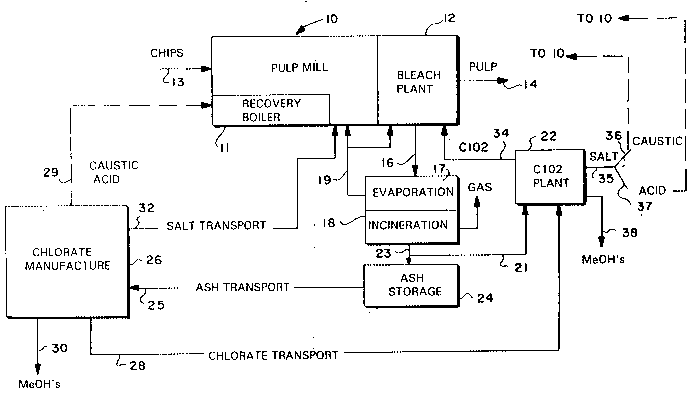Une partie des informations de ce site Web a été fournie par des sources externes. Le gouvernement du Canada n'assume aucune responsabilité concernant la précision, l'actualité ou la fiabilité des informations fournies par les sources externes. Les utilisateurs qui désirent employer cette information devraient consulter directement la source des informations. Le contenu fourni par les sources externes n'est pas assujetti aux exigences sur les langues officielles, la protection des renseignements personnels et l'accessibilité.
L'apparition de différences dans le texte et l'image des Revendications et de l'Abrégé dépend du moment auquel le document est publié. Les textes des Revendications et de l'Abrégé sont affichés :
| (12) Demande de brevet: | (11) CA 2151172 |
|---|---|
| (54) Titre français: | PRODUCTION DE DIOXYDE DE CHLORE POUR UNE USINE DE PATES A DEVERSEMENT NUL |
| (54) Titre anglais: | CHLORINE DIOXIDE GENERATION FOR A ZERO DISCHARGE PULP MILL |
| Statut: | Réputée abandonnée et au-delà du délai pour le rétablissement - en attente de la réponse à l’avis de communication rejetée |
| (51) Classification internationale des brevets (CIB): |
|
|---|---|
| (72) Inventeurs : |
|
| (73) Titulaires : |
|
| (71) Demandeurs : |
|
| (74) Agent: | SMART & BIGGAR LP |
| (74) Co-agent: | |
| (45) Délivré: | |
| (86) Date de dépôt PCT: | 1993-11-16 |
| (87) Mise à la disponibilité du public: | 1994-07-07 |
| Licence disponible: | S.O. |
| Cédé au domaine public: | S.O. |
| (25) Langue des documents déposés: | Anglais |
| Traité de coopération en matière de brevets (PCT): | Oui |
|---|---|
| (86) Numéro de la demande PCT: | PCT/US1993/011054 |
| (87) Numéro de publication internationale PCT: | US1993011054 |
| (85) Entrée nationale: | 1995-06-07 |
| (30) Données de priorité de la demande: | ||||||
|---|---|---|---|---|---|---|
|
Chlorine dioxide for a cellulose pulp mill bleach plant is produced by concentrating (evaporating) liquid effiuents from the bleach
plant to a concentration level high enough for incineration, incinerating the concentrated effluents to produce an ash, chemically reacting
at least a part of the ash to produce chlorate, and using the chlorate in the manufacture of chlorine dioxide. The ash is purified to produce
sodium chloride and the sodium chloride is reacted with oxygen and external energy to produce sodium chlorate. The chlorate is then used
in the manufacture of chlorine dioxide. Sulfates produced are used to manufacture acid and/or caustic, and heavy metal hydroxides are
disposed of. A part of the ash may be used directly in chlorine dioxide manufacture. At least some of the salt from chlorate manufacture
may be fed to the chemical recovery loop, including a recovery boiler, in the pulp mill. Evaporated gases may be returned to the pulp mill
and bleach plant.
Note : Les revendications sont présentées dans la langue officielle dans laquelle elles ont été soumises.
Note : Les descriptions sont présentées dans la langue officielle dans laquelle elles ont été soumises.

2024-08-01 : Dans le cadre de la transition vers les Brevets de nouvelle génération (BNG), la base de données sur les brevets canadiens (BDBC) contient désormais un Historique d'événement plus détaillé, qui reproduit le Journal des événements de notre nouvelle solution interne.
Veuillez noter que les événements débutant par « Inactive : » se réfèrent à des événements qui ne sont plus utilisés dans notre nouvelle solution interne.
Pour une meilleure compréhension de l'état de la demande ou brevet qui figure sur cette page, la rubrique Mise en garde , et les descriptions de Brevet , Historique d'événement , Taxes périodiques et Historique des paiements devraient être consultées.
| Description | Date |
|---|---|
| Inactive : CIB de MCD | 2006-03-11 |
| Inactive : CIB de MCD | 2006-03-11 |
| Inactive : CIB de MCD | 2006-03-11 |
| Demande non rétablie avant l'échéance | 2001-11-16 |
| Le délai pour l'annulation est expiré | 2001-11-16 |
| Inactive : Abandon.-RE+surtaxe impayées-Corr envoyée | 2000-11-16 |
| Réputée abandonnée - omission de répondre à un avis sur les taxes pour le maintien en état | 2000-11-16 |
| Demande publiée (accessible au public) | 1994-07-07 |
| Date d'abandonnement | Raison | Date de rétablissement |
|---|---|---|
| 2000-11-16 |
Le dernier paiement a été reçu le 1999-11-15
Avis : Si le paiement en totalité n'a pas été reçu au plus tard à la date indiquée, une taxe supplémentaire peut être imposée, soit une des taxes suivantes :
Les taxes sur les brevets sont ajustées au 1er janvier de chaque année. Les montants ci-dessus sont les montants actuels s'ils sont reçus au plus tard le 31 décembre de l'année en cours.
Veuillez vous référer à la page web des
taxes sur les brevets
de l'OPIC pour voir tous les montants actuels des taxes.
| Type de taxes | Anniversaire | Échéance | Date payée |
|---|---|---|---|
| Enregistrement d'un document | 1997-09-12 | ||
| TM (demande, 4e anniv.) - générale | 04 | 1997-11-17 | 1997-11-07 |
| Enregistrement d'un document | 1997-12-05 | ||
| TM (demande, 5e anniv.) - générale | 05 | 1998-11-16 | 1998-11-05 |
| TM (demande, 6e anniv.) - générale | 06 | 1999-11-16 | 1999-11-15 |
Les titulaires actuels et antérieures au dossier sont affichés en ordre alphabétique.
| Titulaires actuels au dossier |
|---|
| AHLSTROM MACHINERY OY |
| Titulaires antérieures au dossier |
|---|
| HANS G. LINDBERG |